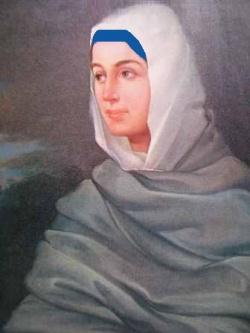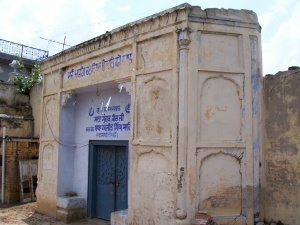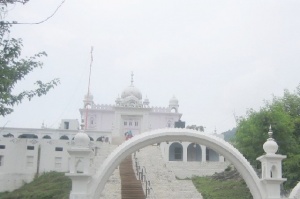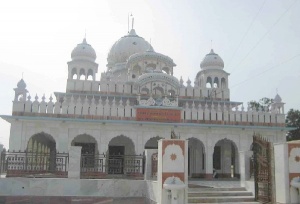Mata Sunder Kaur
| Mata Sunder Kaur | |
| Full Name : | Sunder Kaur, Sundaro |
| Birth : | Bajwara, Hoshiarpur |
| Parents : | Bhai Ram Saran |
| Spouse : | Guru Gobind Singh |
| Children : | Ajit Singh |
| Death : | Delhi |
Mata Sunder Kaur (Mata Sundri) was the wife of Guru Gobind Singh (1666-1708).
She was the daughter of Bhai Ram Saran, a Kumarav Khatri of Bajwara, in present-day Hoshiarpur district of the Punjab. She was married to the tenth Sikh Guru at Anandpur on 4 April 1684. She was the second wife of tenth Sikh Guru Guru Gobind Singh ji.
One son was born to Mata Sundari (Kaur) ji- Baba Ajit Singh (b:11 February 1687). Mata ji received Amrit at the 1699 Vaisakhi Amrit Sanchaar ceremony and adopted the name 'Sunder Kaur'. Mata Sundari raised her son telling the martyrdom tales of their grandfather Guru Tegh Bahadur and great great grandfather Guru Arjan Dev. She told them that a Sikh never runs from a battle field. It was because of her teachings that her son attained Martyrdom. Baba Ajit Singh, the only son 15 years old attained matrydom fighting with Mughals.
During the evacuation of Anandpur on the night of 5-6 Poh 1705, Mata Sundari ji, along with Mata Sahib Devan (who adopted the name 'Sahib Kaur' after recieving Amrit), was escorted by Bhai Mani Singh ji to Delhi.
She rejoined Guru Gobind Singh in 1706 at Talwandi Sabo, where she heard the news of the martyrdom of her sons also of the death of her aged mother-in-law, Mata Gujar Kaur ji. She went back to stay at Delhi while Guru Gobind Singh left Talvandi Sabo for the South. At Delhi, Mata Sundari ji adopted a young boy whom she named Ajit Singh because of his resemblance to her own late son, Sahibzada Ajit Singh ji. After the passing away of Guru Gobind Singh ji at Nanded in October 1708, the Sikhs looked up to her for guidance. She appointed Bhai Mani Singh ji to manage the sacred shrines at Amritsar and also commissioned him to collect the writings of Guru Gobind Singh ji. She also issued under her own seal and authority hukamnamas to sangats. The hukamnamas since discovered and published bear dates between 12 October 1717 and 10 August 1730.
Mata Sundari ji was disappointed in her adopted son, Ajit Singh. Emperor Bahadur Shah treated him as the successor of Guru Gobind Singh ji, called him to his court and gave him a robe of honour in September 1710. This went to his head and he started living in style as a courtier. He grew arrogant and haughty even towards Mata Sundari who disowned him, and migrated to Mathura.
Ajit Singh was later convicted for murder and was put to death on 18 January 1725. Mata Sundari ji returned to live in Delhi where she, died in 1747. A memorial in her honour stands in the compound of Gurdwara Bala Sahib, New Delhi.
Mata Jito/Mata Sunderi - Single Identity
The article have personal research of a person:
Researcher 1:
Author has personally visited angetha sahib of Mata jito (kaur) ji, Mata Sundari (Kaur) ji and Mata Sahib Kaur ji. Mata jito ji's last rites were performed in Anandpur sahib in presence of Guru Gobind Singh ji according to Suraj parkash. While last rites of Mata Sundari ji and Mata Sahib Kaur ji were performed in Delhi.
According to Suraj parkash, Guru sahib had three wives namely: 1) Mata jito ji: eldest wife, three sons (Baba Jujhar Singh ji, Baba zorawar Singh ji Baba Fateh Singh ji.). 2) Mata sundari ji: second wife, one son (Baba Ajit Singh ji). 3) Mata sahib Kaur ji: Third wife, married in 1700. Mughal writers refer Mata Sahib Kaur ji as 'kuara daula' (unmarried but wife). When Mata ji asked for son, Guru ji looking at Khalsa said these all are your sons. After death of Mata jito ji around 1700. Mata Sahib Kaur ji was referred as 'Mother of Khalsa'.
The sources which refers Mata Jito (kaur)ji and Mata Sundri (kaur) ji are seperate personalities are Gur Partap Suraj Granth by Bhai Santokh Singh, Twarikh Guru khalsa Giani Gian Singh, Bansavalinama Dasan patshahiyan Ka by Kesar Singh Chibber.
Researcher 2:
According to Encyclopedia of Sikhism edited by Harbans Singh ji and Reasearch by Dr. Gurbaksh Singh ji, on Mata Jito and Mata Sundri, they were two separate persons and only one was married to Guru Gobind Singh.
The impression that the Guru had more than one wife was created by those writers who were ignorant of Punjabi culture. Later authors accepted those writings indicating more than one marriage of the Guru and believed that having more than one wife was a priviledge or royal act. During those days kings, chiefs, and other important people usually had more than one wife as a symbol of their being great and superior to the common man. Guru Gobind Singh ji, being a true king, was justified in their eyes to have had more than one wife, but Guru Gobind Singh had only one wife.
In Punjab, there are two and sometimes three big functions connected with marriage, i.e., engagement, Wedding, and Muklawa. A big often festive gathering with gana bajana (singing and dancing) is held at all three of these functions. In the past in many cases, an engagement was held as soon as the person had passed the infant stage, marriage was often an arranged event to bring together or unite different tribes. One of the more famous of these weddings was the one arranged for the mother of Ranjit Singh which led to a more cohesive Misl unit (uniting of previously warring tribes) which allowed the 12 misls to eventualy unite under Maharaja Ranjit Singh's rule. Even Shakespeare's tale of Romeo and Juliet would have had a happier ending had the warring families united in a marriage.
Even today engagements at 8 to 12 years of age are not uncommon in some interior parts of India. Now the wedding is performed years later when the engaged couple has reached adulthood. After the wedding, it takes another couple of years for the bride to move in with her in laws and live there. This is called Muklawa. A dowry and other gifts to the bride are usually given at this time of the ceremony to help the couple to establish a new home. Today the wedding and Muklawa are performed on the same day and only after the partners have become adults. Arranged weddings where a couple grow to love and respect each other over a lifetime is still more common in India than the so called love match more common in the West.
A big function, befitting the Guru and other joyful activities were held at Anand Pur, according to custom, at the time of the engagement of the Guru. The bride, Mata Jeeto Ji, resided at Lahore, which was the capital of the Mughal rulers who were not, at that time, on good terms with the Guru. When the time for the marriage ceremony came, it was not considered advisable for the Guru to go to Lahore, along with the armed Sikhs in large numbers. Furthermore, it would involve a lot of traveling and huge expenses, in addition to the inconvenience it would cause the Sangat, especialy the younger and older members, who wished to witness the marriage of the Guru.
Therefore, as mentioned in the Sikh chronicles, Lahore was 'brought' to Anand Pur Sahib for the marriage instead of the Guru going to Lahore. A scenic place a couple of miles to the north of Anand Pur was developed into a nice camp for the marriage. This place was named Guru Ka Lahore. Today, people are going to Anand Pur visit this place as well. The bride was brought to this place by her parents and the marriage was celebrated with a very huge gathering attending the ceremony.
The two elaborate functions, one at the time of engagement and the other at the time of the marriage of the Guru, gave the outside observers the impression of two marriages. They had reason to assume this because a second name was also there, i.e., Mata Sundari Ji. After the marriage, there is a custom in the Panjab of giving a new affectionate name to the bride by her inlaws. Mata Jeeto Ji, because of her fine features and good looks, was named Sundari (beautiful) by the Guru's mother. The two names and two functions gave a basis for outsiders to believe that the Guru had two wives. In fact, the Guru had only one wife with two names as explained above.
Some historians even say that Guru Gobind Singh ji had a third wife, Mata Sahib Kaur. In 1699, the Guru asked her to put pataasas (puffed sugar) in the water for preparing Amrit when he founded the Khalsa Panth. Whereas Guru Gobind Singh ji is recognized as the spiritual father of the Khalsa, Mata Sahib Kaur ji is recognized as the spiritual mother of the Khalsa. People not conversant with the Amrit ceremony mistakenly assume that Mata Sahib Kaur ji was the wife of Guru Gobind Singh ji. As Guru Gobind Singh ji is the spiritual but not the biological father of the Khalsa, Mata Sahib Devan ji is the spiritual mother of the Khalsa, Mata Sahib Devan is the spiritual mother of the Khalsa but not the wife of Guru Gobind Singh. From ignorance of Punjabi culture and the Amrit ceremony, some writers mistook these three names of the women in the life of Guru Gobind Singh as the names of his three wives.
Another reason for this misunderstanding is that the parents of Mata Sahib Devan, as some Sikh chronicles have mentioned, had decided to marry her to Guru Gobind Singh ji. When the proposal was brought for discussion to Anandpur, the Guru had already been married. Therefore, the Guru said that he could not have another wife since he was already married. The dilemma before the parents of the girl was that, the proposal having become public, no Sikh would be willing to marry a woman who had been betroved to the Guru. The Guru agreed for her to stay at Anand Pur but without accepting her as his wife.
The question arose, as most women desire to have children, how could she have one without being married. The Guru told that, "She will be the 'mother' of a great son who will live forever and be known all over the world."
People came to understand the hidden meaning of his statement only after the Guru asked Mata Sahib Devan to add sweetness to the Amrit by bringing patasas which has forever associated her with the birth of the Khalsa. It is, therefore, out of ignorance that some writers consider Mata Sahib Devan as the worldly wife of Guru Gobind Singh.
See Also
References
- Mata Jito Ji
- Harbans Singh "The encyclopedia of Sikhism. "




